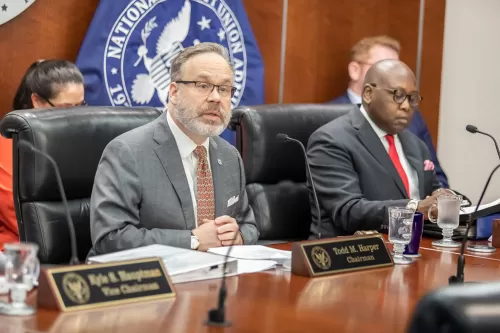NCUA Chairman Todd M. Harper speaks during a meeting of the NCUA's Board.
As Prepared for Delivery on April 20, 2023
Thank you, Rachel, Lisa, and Marvin, for your excellent presentation and leadership on the Climate Financial Risk Working Group. Additionally, I want to thank other team members from across the NCUA’s program offices for their contributions in bringing this request for information before the NCUA Board for consideration today. This Saturday is also Earth Day, an annual event highlighting the importance of protecting the environment. So, there is no better time than now for the NCUA Board to act on this important matter.
As a regulator and insurer, the NCUA has a duty to ensure the institutions it oversees remain resilient against all material risks. Those risks include climate-related financial risks. This request for information is essential to furthering our understanding of these issues and their implications for the overall resiliency of individual credit unions, the vibrancy of the credit union system, and the strength of the National Credit Union Share Insurance Fund.
Climate change continues to accelerate, and the costs of climate-related natural disasters are rising, often hitting disadvantaged communities the hardest. According to the National Oceanic and Atmospheric Administration, the United States experienced 20 separate billion-dollar weather and climate-related disasters across the U.S. in 2021, causing more than $156 billion in damage.1
In 2022, there were an estimated 15 billion-dollar-plus disaster events costing in excess of $171 billion, making it the eighth straight year with 10 or more billion-dollar-plus disaster events.2 And, an analysis by the research nonprofit Climate Central found that from 2017 to 2021, the nation experienced a billion-dollar-plus disaster every 18 days on average, compared with 82 days on average between such events in the 1980s.3
Moreover, in an NCUA Research Note released yesterday, our Office of the Chief Economist found roughly one in four of all federally insured credit unions are located in communities classified as having a relatively high or very high risk of experiencing negative effects due to natural hazards.4 Specifically, the research showed:
- The 25 percent of credit unions located in communities at relatively high or very high risk of experiencing adverse outcomes from natural hazards accounted for 34 percent of system-wide assets, or approximately $750 billion, at the end of 2021.
- Minority depository institutions face a substantially higher risk than the credit union system as a whole.
- Credit unions most at risk of negative outcomes due to natural hazards tend to be located in coastal areas, particularly in California, Texas, and Florida. These three states account for 11 percent of credit unions located in communities with an elevated risk and 22 percent of credit union assets.
Floods, droughts, wildfires, blizzards, hurricanes, tornadoes, and other climate-related events damage or destroy homes, farms, small businesses, vehicles, and vital infrastructure like roads, bridges, levees, and sewer systems that connect these homes, farms, and small businesses to each other. This damage has a cost, including to federally insured credit unions that finance such house purchases and member small business projects.
With this request for information, the NCUA is interested in better understanding stakeholders’ views and experiences on climate-related financial risk. Commenters are encouraged to discuss any relevant issues they believe the NCUA Board should consider about the financial risks associated with climate. This includes but is not limited to risks posed, or stemming from issues around field of membership, lending, investments, other assets, deposits, underwriting standards, insurance coverage, liquidity, and capital.
Anyone who is a stakeholder — those within the credit union system and interested parties outside of it — is encouraged to provide the NCUA with comments. It is important that the NCUA understand any potential risks extreme weather events may have on the credit union system and individual credit union balance sheets. The answers we receive may also allow us to discern what tools credit unions would like to have to assist them in effectively monitoring, managing, and mitigating climate-related financial risks.
Finally, it is worth noting that the NCUA’s request is for informational purposes only. Responses to this request for information will not be used as part of the current NCUA examination and supervision program. Moreover, my fellow Board Members and I fully agree if there were a subsequent change in agency policy and supervision related to climate financial risk, that change would be agreed upon by Board action, similar to any other policy changes we make.
That concludes my remarks. I now recognize Vice Chairman Hauptman.
1 See https://www.ncei.noaa.gov/access/monitoring/billions/time-series as of April 18, 2023.
2 Same source as the prior footnote.
3 Please see the full study at https://www.climatecentral.org/climate-matters/billion-dollar-disasters-in-2022.
4 See https://ncua.gov/news/publication-search/climate-financial-risk/estimating-credit-union-exposure-climate-related-physical-risks.



